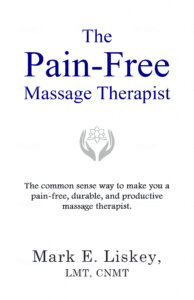Whether you like it or not, you compete with other MTs for business. If that makes you a little uncomfortable, that’s okay. I was uncomfortable with competition at one point in my massage career, too. But as time went on I learned that competition brought out the best in me and that my success depended primarily on one key skill: the ability to deliver the full range of pressures (light, medium and deep).
Competing with Bob
My first job out of massage school was with a chiropractor. Bob, another massage therapist, started about the same time I did. Bob had great hands and was outgoing. He quickly developed a solid client base. I, on the other hand, was shy and unsure. I struggled to retain clients and I didn’t want to compare myself to Bob because I was afraid to face the truth.
Ask Yourself: How Do I Compare?
Eventually I got a few repeat clients and I felt a little better about my job performance. It was at that point that I mustered up the courage to finally ask myself how I compared to Bob. This was terrifying. And liberating. The terrifying part was that Bob had about twice as many clients as I did. The liberating part was now that I saw this cold, hard fact, I could do something about it. And I did.
Pressure is King (And Queen)
In order to be more competitive with Bob I studied and became certified in St. John’s Neuromuscular Therapy (NMT). But you might be surprised when I tell you that working the transverse attachments of a client’s QL (NMT methodology and techniques) was not the game-changing key that brought my client base up to Bob’s. Rather it was my ability to effectively deliver the full range of pressures—light, medium and deep—something NMT also taught me.
The importance of pressure was further reinforced to me when I was training MTs for hotel massage. The main complaint I would hear from new clients was that a previous therapist hadn’t worked deep enough.
Three Key Elements to Delivering Pressure
In order to become confident with your pressure, you’ll need to understand three things:
- Pressure should be consistent throughout a massage. Here’s how you accomplish this: First ask the client during the intake process what pressure she likes. Her answer is only used as a rough starting point. Why? Say your client says she wants medium pressure. Is her perception of medium pressure the same as yours? Maybe—but you don’t know for sure. So you will need to start with your medium pressure, then after a couple of strokes you’ll need to ask her if the pressure you’re doing is the pressure she likes? If not, then you need to adjust your pressure. Once you establish the pressure the client likes best you’ll then reproduce that pressure throughout the massage. I also leave the door open for the client to communicate if she needs more or less pressure by saying: At any point during the massage if you need more or less pressure, just let me know.
- Pressure should be appropriate to the client’s needs. For example, say the client wants deep pressure. So you start by establishing the deep pressure the client wants, but then you hit a tight area and the client jumps. You’re obviously going to want to back off on your pressure. However, if you hit a tight area and the clients wants you to go deeper, you’ll have to ramp up your deep pressure to super-deep. Each client is different. The important thing is to figure out quickly which action—more or less pressure—produces a pain relief and/or a relaxing response and then apply the appropriate pressure.
- Pressure should be precise when working a tight or tender area so that you can zero in on the exact area of pain. Fingertips, thumbs, knuckles and elbows are the best tools to transmit precise pressure. A tool transition from a broad tool (palms, forearms and fists) to a precise tool (fingers, elbows and knuckles) can be seamless with a little practice. Take a look at the Deep Tissue—Transitions video on our Facebook page https://www.facebook.com/themassageinstitute.net/.
Where Do You Stand?
It’s never easy when you compare yourself to other MTs. If you’re in a fragile state it’s okay to wait until you get a couple of wins under your belt, aka, happy customers. But at some point you have to look up, survey the people in the room and ask yourself: Where do I stand amongst my colleagues? If you don’t like the answer, take a good look at your pressure. Is it consistent throughout the massage? Is it the pressure the client requested? And is the pressure appropriate and precise for tight/tender areas? If you fix the pressure, you more than likely will find your competitive edge (whether you want it or not).
How to Deliver Deep Pressure Online, CEU Class
In this massage body mechanics course I’m going to make sure that you know exactly what to do to be competent at delivering deep pressure without hurting yourself.
However, there’s a caveat here: You’re going to be challenged in this course. Not in a bad way.
You’re going to be challenged to use your body in a non-traditional way that will allow you to deliver pressure efficiently and with minimal effort.
Specifically, you’re going to learn how to lean so that you can use your body weight to generate pressure. That means your upper-body won’t be taxed.
Yep, it’s going to feel a little awkward at first, but I promise you that once you get the lean down, you’ll never want to muscle your way through a massage again.
As you learn how to lean I then show you how to use the table for support to take any tension out of your back.
Next, I teach you how to get vertical. In other words, you’re going to stop massaging in the hunchback-massage position. In fact, you’re going to straighten up and stretch during the middle of the massage.
To save you hands, I show you how to combine body parts.
And at the end we smooth out your new body mechanics with killer transitions and an introduction to massage tools for very precise pressure.
Check it out here: How to Deliver Deep Pressure Without Hurting Yourself.







Comments on this entry are closed.
Just a little story for those MTs who are REALLY good at what they do, but nonetheless not very competitive with Bob. When I was in my early 20’s, I was making leather goods. One winter I had a booth at a month-long craft market. My “Bob” had a leather booth near mine. Every time he sold a belt, he used a pounding tool to make the buckle holes for the customer. There were several leather crafters at that market squirming at each loud hole punch indicating another sale for Bob We all agreed that Bob’s work lacked quality- his leather was less resilient and firm, his edges were unfinished, any tooling was unattractive, the dye was smeary, his buckles were cheap. Maybe Bob was also a fast talking Lothario, but he was underpricing us, and selling!
So Mark- I agree being the best massage therapist you can be is the way to go. But The Bobs of the world will always be out there.
Great story, Bobbi! I agree you have to be the best you can be at what you do, but if you don’t let anyone “know” about it, the “Bobs” who are mediocre (but know how to sell) will make more sales.
Bobbi, I know you are an avid runner with lots of medals. How would you rate your competitiveness–low, medium or high? Does competitiveness carry over into massage for you? And if so, has it helped you in your massage business/career?